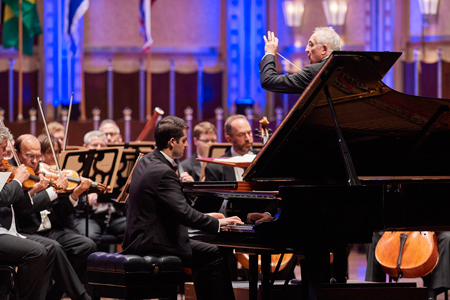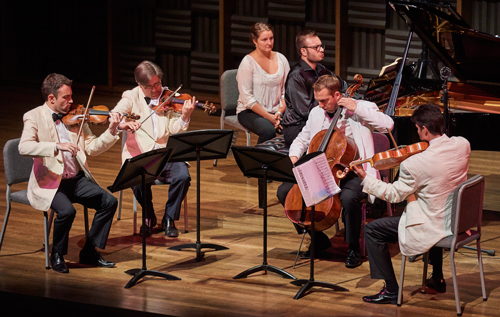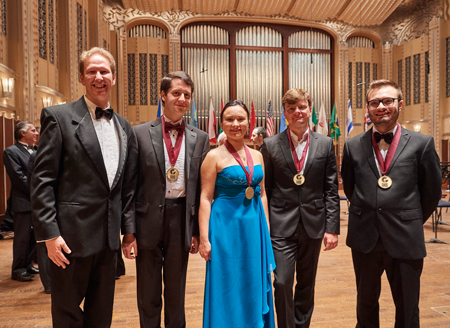by Mike Telin

The competition has been reimagined as a hybrid event with pre-recorded First and Second Rounds — Semi-Final and Final Rounds will take place in Cleveland. Twenty-eight contestants who were chosen for the 2020 competition will compete for an opportunity to perform with The Cleveland Orchestra and to win the Mixon First Prize of $75,000, a New York performance debut, management services, and a recording on the Steinway & Sons label. Click here for a full competition schedule and here for ticket information.
Creating the plan — a logistical jigsaw puzzle
Piano Cleveland president Yaron Kohlberg said in a Zoom conversation that all the decisions during the planning process were made with the best interests of the contestants in mind. “We felt that since we had chosen these contestants in 2019, there was a timeline for us to fulfill our commitment. Had we pushed the competition back another one or two years, participating in CIPC would have already stopped being relevant to many of them — people’s life situations change.” Click here for a complete contestant list.
During the same conversation, Piano Cleveland executive director Marissa Glynias Moore said the organization began planning CIPC 2021 by building on what they had learned during the 2020 Virtu(al)oso Competition.

As a result, three competition scenarios were created. The most optimistic was to produce a traditional CIPC with all contestants coming to Cleveland and competing in front of an in-person audience. The least optimistic was a virtual CIPC that resembled last summer’s Virtu(al)oso. In the middle was the hybrid plan.
“That was the plan we all liked the best,” Glynias Moore said. “We thought, ‘let’s figure out how to leverage everything that was successful in Virtu(al)oso, and combine it with safe, in-person semi-final and final rounds.’ And bringing only eight semi-finalists to Cleveland allows us to figure out how to adhere to any restrictions like a two-week quarantine. So those rounds can take place here even if we can’t have an in-person audience.” She added that the hybrid option preserved the opportunity for the finalists to play with the Escher String Quartet and ultimately with The Cleveland Orchestra.
First- and Second-Round recordings
Recordings of the free First- and Second-Round sessions will be broadcast Thursdays through Sundays, July 8 through 25.

“We spent a lot of time thinking of creative ways to accommodate the contestants,” Yaron Kohlberg said. “The original plan was to do what we did for Virtu(al)oso — choose a couple of locations that contestants could travel to in order to make their recordings, but that didn’t quite work out. As you can imagine, travel restrictions are constantly changing, and for many contestants, they couldn’t leave where they were.”
It quickly became clear that the number of recording locations would need to be increased. “We used our own contact list and teamed up with our friends at the Leeds, Rubinstein, and Sydney competitions,” Kohlberg said. “We have some mutual contestants, so we managed to find a way for them to record for multiple competitions at the same time.” CIPC also tapped into personal connections. “One of our jurors in Virtu(al)oso helped us find the Moscow location, and with Marissa’s contacts at Harvard and my connections in Paris, we managed to make it happen.”
Kohlberg noted that the process was more involved than simply finding locations — they needed to make sure that everybody would be able to record under the same conditions.
“All of the halls are more or less the same size,” he said. “There are also strict rules about setting up the cameras and what types of cameras and microphones can be used. And all the contestants must use a Steinway B that is fifteen years old or less. So the recordings will sound a little bit different from each other but will still be representative of a person’s playing.”
New additions to the Semi-Finals

The Semi-Finals will take place in Gartner Auditorium at the Cleveland Museum of Art from July 29 through August 1. In addition to planning for COVID restrictions, getting the eight contestants to Cleveland also requires applying for travel visas. “Yaron and I have learned so much about the visa process in the last six months,” Glynias Moore said. “All contestants will need a travel visa. If they do not become semi-finalists they will be reimbursed.”
In addition to a 40-minute solo recital, the 2021 CIPC Semi-Finals will also include a duo-piano round. Teams may choose either the Schubert Fantasie in f, or the Mozart Sonata for Two Pianos in D.
“We wanted to give the semi-finalists the opportunity to play twice,” Kohlberg said. “This will also give the jury and the audience a chance to get to know the contestants better. We see this as a great opportunity to form friendships and collaborations, and develop the feeling that we are all in this together. It also reveals a different aspect of one’s playing.”
Kohlberg noted that although there is not much time to prepare the pieces, both works are basic duo-piano repertoire. “A lot of people already know them and if not, they can be learned in a short time.
The addition also advances CIPC’s goal of preparing contestants for careers as pianists. “That doesn’t always mean being a soloist,” Glynias Moore said. “We hear them play solo repertoire, two-piano repertoire, chamber music with the Escher, and finally a concerto with The Cleveland Orchestra.”

Kohlberg also sees the popular song requirement as audience building. “We want to create a space for people who already love classical music, as well as a space for the audiences of tomorrow — no matter what background or age. When people hear a melody that they know, they may be more inclined to listen to other things.”
Contestants can choose from several arrangements commissioned by CIPC: Themes from Mission Impossible (Lalo Schifrin), Bohemian Rhapsody (Queen), America (Leonard Bernstein), and the Olympic Fanfare (John Williams — the Olympics will be occurring at the same time). “Contestants have already been telling me that they’re enjoying practicing them and we hope the audience will enjoy them just as much.”
Planning for a COVID-restricted Final

Four pianists will move on to the Final Round — first performing with the Escher String Quartet at the Cleveland Museum of Art on August 3 and 4 and then moving to Severance Hall for a concerto with The Cleveland Orchestra on August 6 and 7.
“One of our biggest challenges was deciding on the concerto repertoire because the number of people allowed on stage depends on health and safety guidelines,” Glynias Moore said. Piano Cleveland has been working closely with The Cleveland Orchestra since August to create different concerto-round scenarios. Contestants have received a list of concertos divided into three categories. ‘A’ is the most restrictive with the smallest orchestra, ‘B’ includes up to 50 people onstage, and ‘C’ is the usual CIPC concerto repertoire. “It’s in everybody’s best interest for us to wait as long as possible to make the final decision. Right now, we’re projecting to do that in late May.”
Kohlberg added that even if category ‘A’ is used, he will not be disappointed. “It would make it a somewhat different competition but we wouldn’t be unhappy about it. A Rachmaninoff concerto can be captivating, but people often say that when you hear someone play a Mozart concerto and play it well, that’s when you know you’re listening to a real musician. But it’s going to be very interesting, and we will welcome whatever comes with open arms.” Click here for a full required repertoire list.
New competition prize
2021 will also include the new Female Composer Prize. “Just like the popular music transcriptions, we feel strongly about diversifying the classical music canon as well, and this is our first step into that,” Glynias Moore said. “You add a Female Composer Prize and you’re bound to get more pieces by women composers. We already have some for the
First and Second Rounds.” Click here for a complete list of prizes.
The Jury

The expertise of the 2021 jury has been expanded to include an artist manager, a conductor, and a piano festival co-founder. “We’re trying to think about everything that we do on a much broader spectrum,” Kohlberg said. “Classical music’s place in the world right now is very different than it was 50 years ago. And in many ways, things haven’t really evolved in the world of piano competitions.”
Kohlberg expressed concern that many competition winners are not able to maximize their potential. “We want to give them the right guidance to do that, and that starts with the jury,” he said. “You start by assembling a jury of people who can identify the contestants beyond just being great pianists. As we move forward we will stay loyal to tradition, but we’re going to make adjustments to keep in line with the changes that are happening in classical music.”
Glynias Moore noted that the jury for Virtu(al)oso was similarly constructed, with a mix of talents and diverse backgrounds. “We had a lot of positive feedback from audiences about the jury roundtable. Many told us how fascinating it was to hear different perspectives about the same people. That underscored what we already knew to be true — bringing together a diverse jury is very powerful for contestants and audiences.” Click here for a complete list of jury members.
Community outreach
Community programs will begin in early May with the new CIPC listening series Prelude to Piano, allowing you to brush up on your musical knowledge from the comfort of your own home. Presented from the Bop Stop, this virtual three-part series is designed to help both serious and casual classical music fans take their interest and knowledge to the next level in a fun, low-key environment.
As always, CIPC 2021 will include Contestant Community Concerts. “We will have eight semi-finalists and we want to make sure they can be heard by as many people as possible,” Glynias Moore said. “That is challenging because of COVID restrictions, but it is a good opportunity for us to work with our longtime community partners like the Boys & Girls Club.”
On July 8 at 7:00 pm you can catch the CIPC Watch Party at The Van Aken District and enjoy performances under the stars on the big screen.
On July 11 it’s Family Fun Day at The Music Settlement, which includes live musical performances, fun activities, local face-painting, balloon artists, and goodie-bags.
It’s PianoKids Day on July 28 and July 29 in conjunction with the Boys & Girls Club of Cleveland and the East End Neighborhood House.
Master classes will be held July 31 through August 5 at the Cleveland Institute of Music and The Music Settlement.
Published on ClevelandClassical.com March 29, 2021.
Click here for a printable copy of this article



